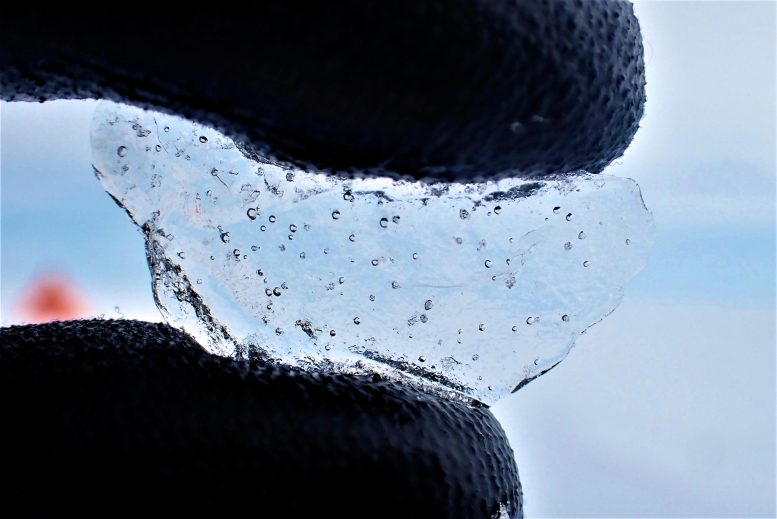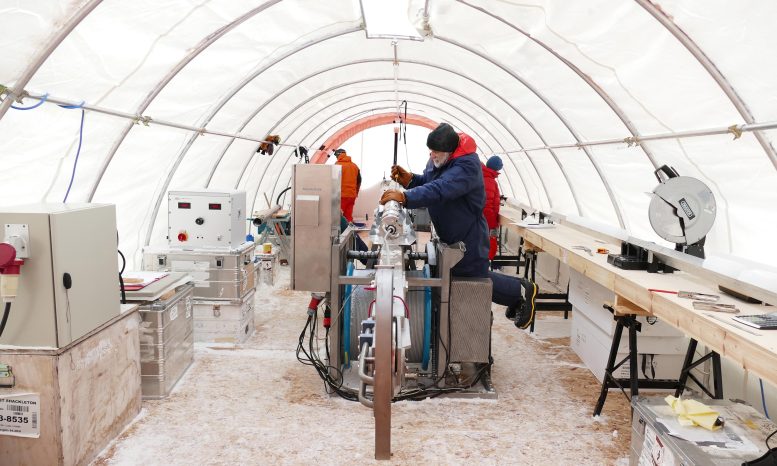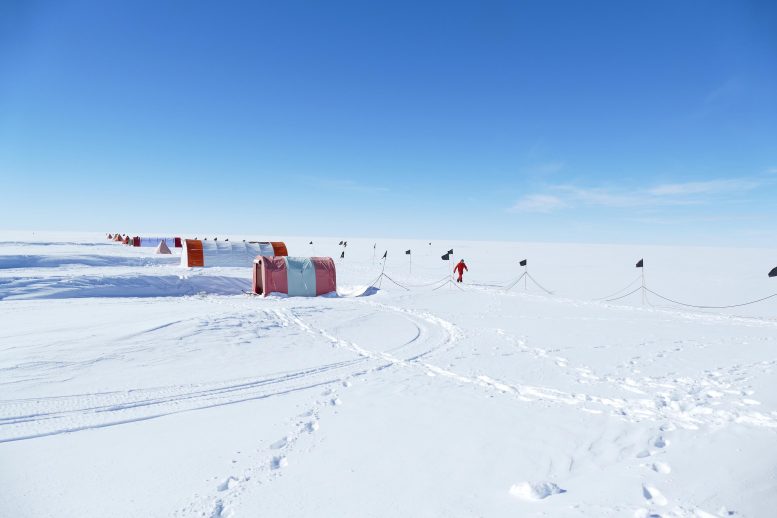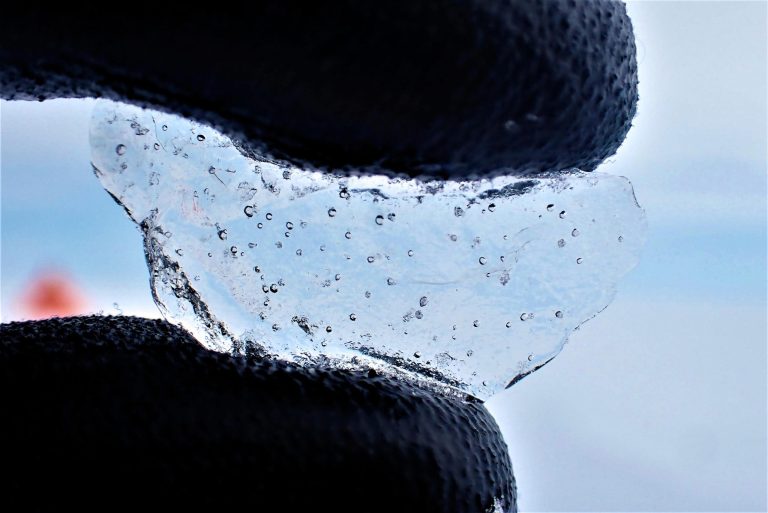
Evidence found inside an ice core shows that at one site, the West Antarctic ice sheet has shrunk by 450 meters – that's more than the height of the Empire State Building – in less than 200 years. Credit: University of Cambridge/British Antarctic Survey
Researchers have discovered rapid ice loss in the West Antarctic Ice Sheet 8,000 years ago, indicating potential future risks under global warming.
Researchers from the University of Cambridge and the British Antarctic Survey have discovered the first direct evidence that the West Antarctic Ice Sheet suddenly and dramatically shrank at the end of the last ice age, about eight thousand years ago.
Evidence, found inside an ice core, shows that in one place, the ice sheet has shrunk by 450 meters – that's more than the height of the Empire State Building – in less than 200 years.
Implications of climate change in the future
This is the first evidence anywhere in Antarctica of such rapid ice loss. Scientists worry that today's rising temperatures could destabilize parts of the West Antarctic Ice Sheet in the future, potentially crossing a tipping point and causing a runaway collapse. The new study published today (February 8) in Natural earth sciencesIt sheds light on how quickly Antarctic ice will melt if temperatures continue to rise.
“We now have direct evidence that this ice sheet suffered rapid ice loss in the past,” said Professor Eric Wolff, senior author of the new study from the University of Cambridge's Department of Earth Sciences. “This scenario is not something that only exists in our model predictions, and could happen again if parts of this ice sheet become unstable.”

Inside the drill tent at Skytrain Ice Rise, engineers and scientists separate the drill's inner barrel from the outer barrel between drilling rounds. Credit: University of Cambridge/British Antarctic Survey
The Antarctic ice sheets, from west to east, contain enough fresh water to raise global sea levels by about 57 metres. The West Antarctica ice sheet is particularly vulnerable because much of it lies on bedrock that lies below sea level.
Model predictions indicate that a large portion of the West Antarctic ice sheet may disappear in the next few centuries, causing sea levels to rise. However, exactly when and how quickly the ice will be lost is uncertain.
Historical context and modern relevance
One way to train ice sheet models to make better predictions is to feed them data on ice loss during warming periods in Earth's history. At the height of the last ice age 20,000 years ago, Antarctic ice covered a larger area than it does today. As our planet melts and temperatures slowly rise, the West Antarctic ice sheet has shrunk to what it is today.
Dr Isobel Royle, co-author of the study, said: “We wanted to know what happened to the West Antarctic ice sheet at the end of the last ice age, when temperatures on Earth were rising, albeit at a slower rate than current human-induced global warming.” From the British Antarctic Survey. “By using ice samples we can go back to that time and estimate the thickness and extent of the ice sheet.”

Pits and living tents at Skytrain Ice Rise. Credit: Eric Wolf
Ice cores are made up of layers of ice formed as snow falls and then buried and compressed to form ice crystals over thousands of years. Within each ice sheet are bubbles of ancient air and pollutants that have mixed with each year's snowfall, providing clues about climate change and the extent of the ice.
Researchers drilled a 651-meter-long ice core from the Skytrain Ice Rise in 2019. This pile of ice is located at the edge of the ice sheet, near the point where ground ice flows into the floating Ronne Ice Shelf.
After transporting ice samples to Cambridge at -20sC, the researchers analyzed it to reconstruct the thickness of the ice. First, they measured stable water isotopes, which indicate the temperature at the time of snowfall. The temperature drops at higher altitudes (think cold mountain air), so they were able to equate the warmer temperatures with thinner ice.
They also measured the pressure of air bubbles trapped in the ice. As with temperature, air pressure also changes regularly with altitude. Lower, thinner ice contains higher pressure air bubbles.
These measurements told them that the ice thinned rapidly 8,000 years ago. “Once the ice became thin, it shrank very quickly. This was clearly a turning point — a runaway process,” Wolf said.
They believe this thinning may have been caused by warm water reaching below the edge of the West Antarctica ice sheet, which typically rests on rock. This likely loosened part of the ice from the rock, allowing it to suddenly float off and form what is now known as the Rhone Ice Shelf. This then allowed the adjacent Skytrain Ice Rise, no longer restricted by grounded ice, to quickly ease off.
The researchers also found that the sodium content of the ice (caused by salt in sea spray) increased about 300 years after the ice melted. This told them that after the ice became thin, the ice shelf shrank again so that the sea was hundreds of kilometers closer to their location.
“We already knew from models that the ice thinned around this time, but the date of that is uncertain,” Rowell said. Ice sheet models have placed retreat anywhere from 12,000 to 5,000 years ago, and have been unable to determine how quickly it occurred. “We now have a very precisely dated observation of this decline that can be incorporated into improved models,” Rowell said.
Although the West Antarctica ice sheet retreated rapidly 8,000 years ago, it stabilized when it reached roughly its present extent. “It's now important to see if additional warmth can destabilize the ice and make it start retreating again,” Wolf said.
Reference: “Sudden loss of Holocene ice due to ice thinning and detachment from land in a Weddell Sea bay” 8 February 2024, Natural earth sciences.
doi: 10.1038/s41561-024-01375-8

